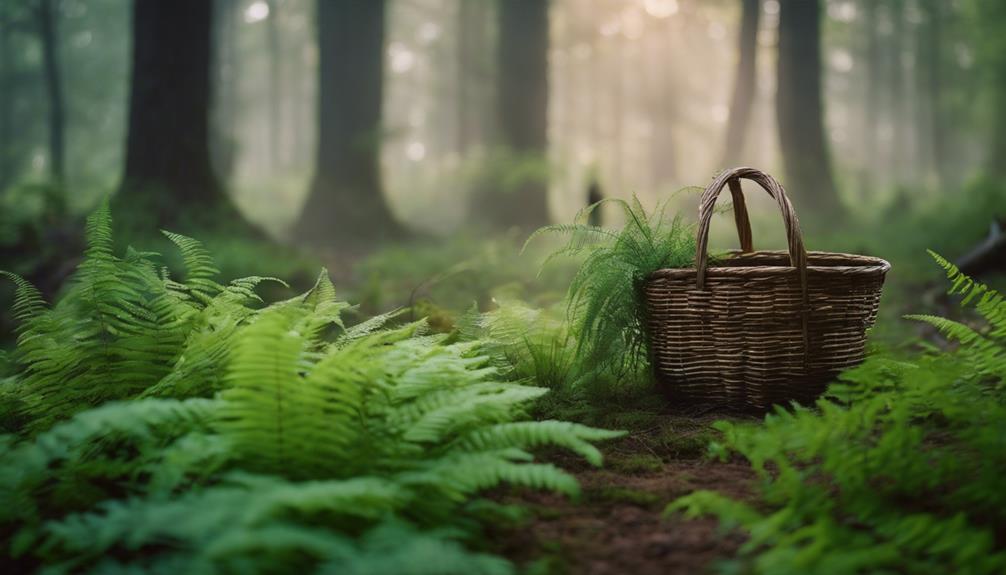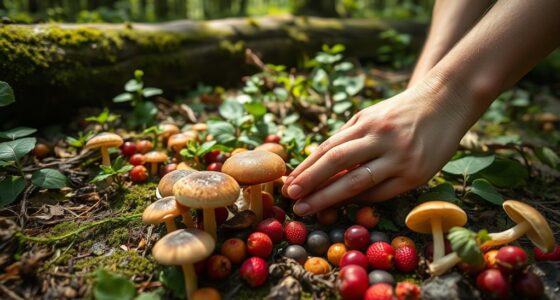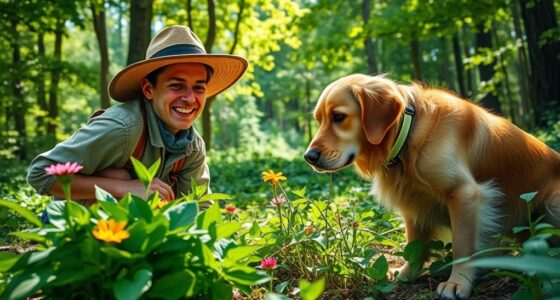Get ready to discover the rich bounty of South Carolina's wild edibles! From pawpaw and persimmon to hickory nuts and highbush blueberries, the Palmetto State offers a diverse array of delicious and nutritious native plants. To forage responsibly, follow best practices like properly identifying plants, obtaining permission, and harvesting only what you need. Understanding the state's ecosystem, including climate variations and terrain features, will also help you find the best spots. As you explore the world of wild edibles, you'll uncover the secrets of sustainable foraging and gain a deeper appreciation for the natural world – and there's even more to uncover.
Key Takeaways
- Identify edible plants correctly, considering regional variations in South Carolina's diverse ecosystem.
- Obtain permission and follow Leave No Trace principles to ensure sustainable foraging practices.
- Harvest native species like pawpaw, persimmon, and hickory nuts, while respecting conservation efforts.
- Understand the importance of native plants in sustaining wildlife interactions and supporting local biodiversity.
- Engage with the local foraging community, support sustainable harvesting, and contribute to the state's economy.
Native Edible Plant Species
As you venture into South Carolina's wilderness, you'll discover a diverse array of native edible plant species waiting to be foraged, each offering unique flavors and nutritional benefits.
Foragers harvest these wild edibles, taking advantage of the state's rich biodiversity. Pawpaw, persimmon, and hickory nuts are just a few examples of the many edible plants that can be found.
Understory plants like highbush blueberries and Hawthorn trees yield delicious berries suitable for various culinary uses. Native plants like Chickweed and Sassafras provide edible greens and roots, adding diversity to foraged meals.
Serviceberry fruits, resembling blueberries, can be enjoyed raw or cooked, contributing to a rich foraging experience in South Carolina. Persimmon and mulberry trees offer sweet fruits for consumption or culinary exploration, showcasing the diverse wild bounty of South Carolina.
Foraging Best Practices

As you start foraging, remember that knowing your plants is essential, and respecting the land is vital.
You'll want to familiarize yourself with the best practices to guarantee a safe and sustainable foraging experience.
Know Your Plants
When venturing out to forage for edible plants, you must properly identify the species you come across to guarantee a safe and successful harvest. You don't want to mistake a wild, edible plant for a toxic lookalike, which could be harmful or even fatal.
To avoid this, consult reliable resources like field guides or experienced foragers to learn about edible plants. Understand the characteristics of these plants, including their leaves, stems, fruits, and roots. Be cautious of poisonous lookalikes that may resemble edible species. Learn about the specific habitats where edible plants grow to increase your foraging success.
Respect the Land
Before you start foraging, make sure you've obtained permission to forage on private or public property, respecting landowners and conservation efforts. This is important to make sure you're not trespassing or disrupting sensitive ecosystems.
As a responsible forager, it's vital to follow Leave No Trace principles, minimizing your impact on the environment. Stay on trails, avoid disturbing wildlife habitats, and never litter.
When you're out foraging, remember to harvest only what you need, avoiding overharvesting that can harm the ecosystem. Your guide to foraging wild edible plants should emphasize sustainability and respect for nature.
When preparing your foraged ingredients, make sure to properly dispose of any waste and packaging, keeping the foraging areas clean and free of litter.
Understanding South Carolina's Ecosystem

As you explore South Carolina's ecosystems, you'll encounter diverse regions, each with its unique characteristics.
You'll find coastal regions with salt-tolerant plants, areas with distinct climate variations, and mountainous terrain features that support a wide range of edible species.
Understanding these regional differences is essential for successful foraging and ensuring the long-term sustainability of the state's wild edible plants.
Coastal Regions Diverse
South Carolina's coastal regions boast an incredible diversity of ecosystems, from marshes and estuaries to maritime forests, creating a unique tapestry that supports a wide range of native edible plants.
As you explore these coastal regions, you'll discover an abundance of wild, edible plants that have adapted to the unique conditions of the area. You'll find yaupon holly, beach peas, and coastal sage growing in abundance along the coast. The marshes and estuaries provide a habitat for native species like sea oats, beach plums, and marsh elder.
Understanding the coastal ecosystem is essential for successful foraging, as it influences the types of edible plants that thrive in the region. By familiarizing yourself with the coastal regions' diverse ecosystems, you'll be better equipped to identify and harvest the rich bounty of wild, edible plants that South Carolina's coast has to offer.
Regional Climate Variations
You'll find that South Carolina's regional climate variations play a significant role in shaping the state's diverse ecosystems, which in turn support an incredible array of native edible plants.
The state's humid subtropical climate, with hot summers and mild winters, creates an ideal environment for a wide range of edible flora to thrive. However, it's crucial to understand the regional climate variations to optimize your foraging strategies.
Coastal regions experience milder temperatures, while upstate areas have cooler conditions, affecting the types of edible plants that grow in each region. As you plan your foraging excursions, consider the seasonal changes in South Carolina, which impact the availability and growth patterns of native edible plants.
Mountainous Terrain Features
Frequently, foragers flock to South Carolina's mountainous terrain in the northwest region, where a diverse ecosystem unfolds with unique plant species that thrive in the Blue Ridge Mountains. As you venture into this mountainous terrain, you'll discover a haven for edible plants. The elevations, ranging from 3,000 to 5,000 feet, create an ideal environment for a variety of plants to flourish.
Native edible plants like ramps, fiddlehead ferns, and wild berries are commonly found in this terrain. Understanding the specific mountainous terrain features can help you, as a forager, identify and harvest edible plants safely and responsibly. The unique combination of soil, climate, and topography in this region creates a perfect blend for these plants to thrive.
As you explore the mountainous terrain, keep an eye out for these hidden gems, and remember to forage responsibly to uphold the ecosystem's balance. By doing so, you'll be able to enjoy the bounty of South Carolina's wild edibles while preserving the natural beauty of the Blue Ridge Mountains.
Cultivation and Propagation

By understanding regional soil conditions, you can successfully cultivate native edible plants in South Carolina. To achieve this, it's vital to acquire local plant varieties that are well-suited to the region's climate and soil composition. By doing so, you'll enhance growth outcomes and promote better adaptation to the environment.
When cultivating native plants, it's important to employ specific agricultural practices tailored to South Carolina's unique climate and soil composition. This includes proper planting techniques, such as soil preparation and watering, which contribute to healthy and productive gardens. Additionally, utilizing direct sowing or starts and transplants based on plant preferences can optimize cultivation efforts.
Wildlife and Plant Relationships

In South Carolina's ecosystem, native plants are intertwined with wildlife in a delicate dance of mutualism, where each species relies on the other for survival and thrival. You'll find that native plants sustain a complex web of interactions, providing food and shelter for various wildlife species. As you forage for edible plants, remember that pollinators like bees, butterflies, and hummingbirds are vital for plant reproduction.
| Wildlife | Role in Ecosystem | Impact on Native Plants |
|---|---|---|
| Bees, Butterflies, Hummingbirds | Pollinators | Enable plant reproduction |
| Birds | Seed Dispersal | Spread seeds through consumption and droppings |
| Various Wildlife | Seed Consumers | Aid in seed dispersal and plant spread |
| Wildlife in General | Ecosystem Engineers | Maintain biodiversity and ecosystem balance |
As you explore South Carolina's wild bounty, it's important to recognize the intricate relationships between wildlife and native plants. This delicate balance is necessary for maintaining biodiversity, and your understanding of these relationships will enhance your foraging experience.
Conservation and Environmental Impact

As you venture into South Carolina's wild to forage for edible plants, you're likely to appreciate the state's conservation efforts, which protect indigenous species and preserve biodiversity. South Carolina implements conservation strategies to safeguard its unique flora, ensuring the long-term sustainability of native edible plants.
Laws are in place to prevent overharvesting and land misuse, allowing indigenous species to thrive. Educational programs raise awareness about the importance of preserving native species and their ecosystems, promoting responsible foraging practices.
Habitat conservation efforts are essential for restoring and maintaining natural environments where wild edibles grow. Local communities and conservation groups collaborate to sustain and protect South Carolina's unique edible plant species. By supporting these conservation efforts, you're contributing to the preservation of the state's rich biodiversity.
As you forage for wild edibles, remember that responsible harvesting practices and conservation efforts go hand in hand, ensuring the state's natural beauty and bounty for generations to come. Always make sure to properly identify plants before consuming them, as many wild species have toxic look-alikes. Additionally, avoid over-harvesting from any one area to allow ecosystems to regenerate naturally. When you forage for wild edibles in Maryland, be mindful of local regulations and guidelines, respecting both nature and the communities that depend on its resources.
Uses of Native Plants

You'll discover that native plants in South Carolina have been an essential part of the region's cultural heritage, serving as a rich source of food and medicine for centuries.
As you forage for edible plants, you'll find that many wild plants offer delicious and nutritious treats. Persimmon and mulberry trees, for instance, provide sweet fruits that are perfect for snacking or adding to your favorite recipes. Hickory trees yield rich-flavored nuts like Pignut and Mockernut, which can be enjoyed raw or roasted. Blueberry shrubs and Hawthorn trees produce edible berries that are great in jams, smoothies, or as a topping for oatmeal or yogurt.
When you're out foraging, keep an eye out for herbaceous plants like Chickweed and Sassafras, which offer edible greens and roots. These wild plants can add fresh flavor and nutrition to your meals.
As you explore South Carolina's wild bounty, remember to always identify plants correctly and harvest responsibly to safeguard their continued growth. With a little knowledge and practice, you can enjoy the rich flavors and health benefits of these native plants.
Community and Economic Aspects

Beyond the personal benefits of foraging, the pursuit of wild edibles also has a profound impact on the community and local economy. By embracing foraging, you're not only improving your own health and connection with nature, but also contributing to the growth of a sustainable food culture in South Carolina.
Here are just a few ways that foraging can benefit your community and local economy:
- Community foraging events bring people together, fostering a sense of camaraderie and shared knowledge among foragers.
- By supporting local foragers and businesses that utilize wild ingredients, you're promoting a more diverse and sustainable food culture.
- Foraging can strengthen community bonds, as individuals come together to explore nature, share experiences, and learn about the rich bounty of wild edibles in South Carolina.
- Sustainable harvesting practices are promoted through education and community outreach, ensuring the long-term health of our ecosystems.
- Foraging can even contribute to the local economy, as unique ingredients are sold to chefs and restaurants, supporting local businesses and entrepreneurs.
Frequently Asked Questions
How to Forage Wild Edible Plants?
You'll want to start by learning to identify wild edibles, then seek permission to forage on private or public land, and begin with small quantities to test for reactions before diving into the world of foraging!
How Do Beginners Do Forage?
You start foraging by learning about common edibles, joining guided hikes, and using reputable resources to enhance your knowledge. Begin in safe areas, practice ethical harvesting, and only take what you need, leaving enough for wildlife and future growth.
Where to Forage in South Carolina?
You're on a treasure hunt, searching for the holy grail of wild edibles! In South Carolina, you'll strike gold in Francis Marion National Forest, state parks, and coastal regions, where sea beans and coastal herbs await your discovery.
How Do You Know a Wild Plant Is Safe to Eat?
You verify that a wild plant is safe to eat by positively identifying it using reliable resources, avoiding contaminated areas, and being cautious of lookalikes, then educating yourself on proper preparation methods and testing for reactions.
Conclusion
As you venture into South Carolina's wild, remember that foraging isn't just about finding food, but about respecting the land and its inhabitants.
By embracing sustainable practices, honoring plant-wildlife relationships, and promoting conservation, you become a guardian of the state's natural treasures.
So, go ahead, harvest with care, and let the Palmetto State's wild bounty nourish your body and soul.










